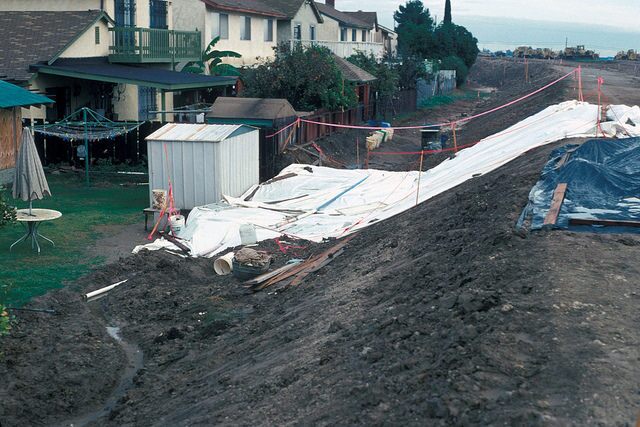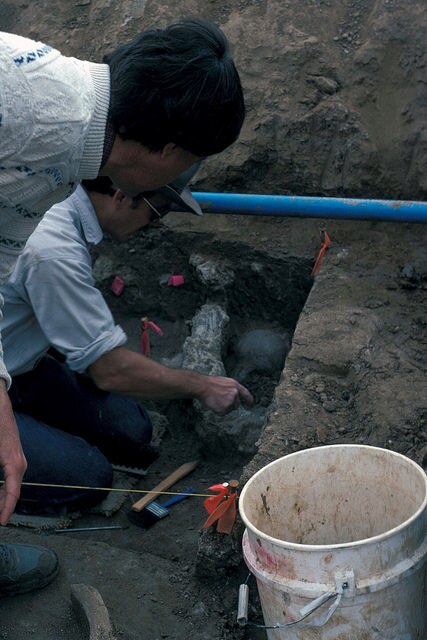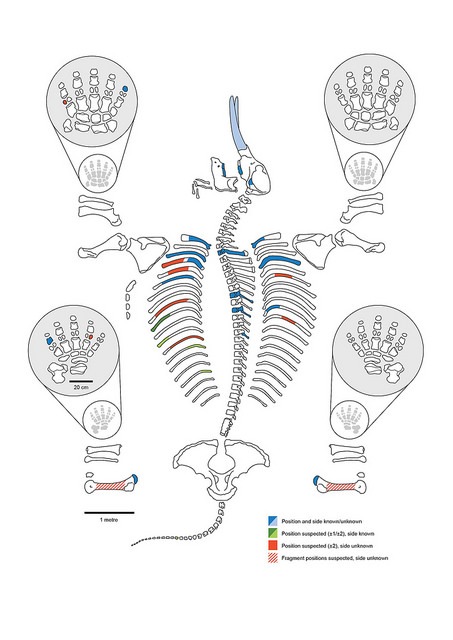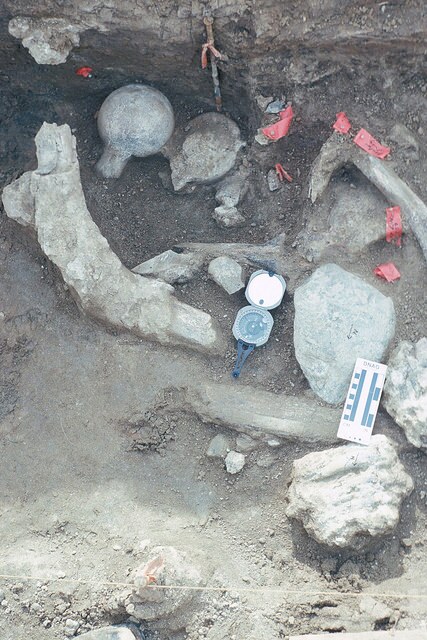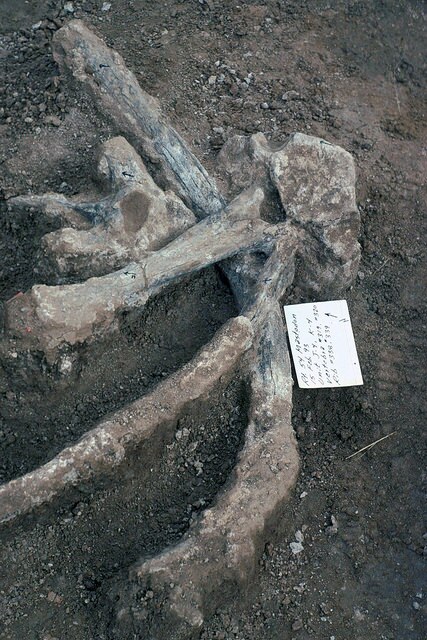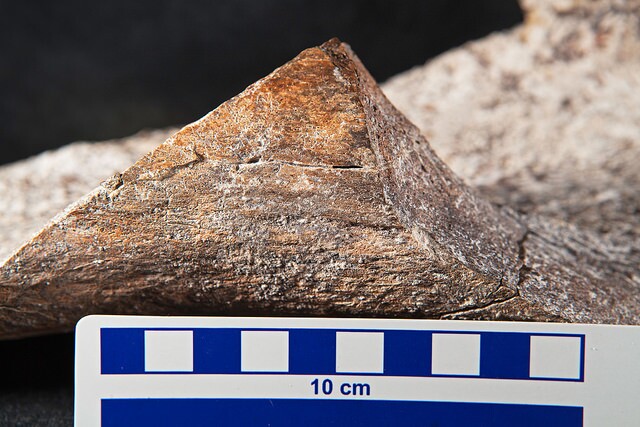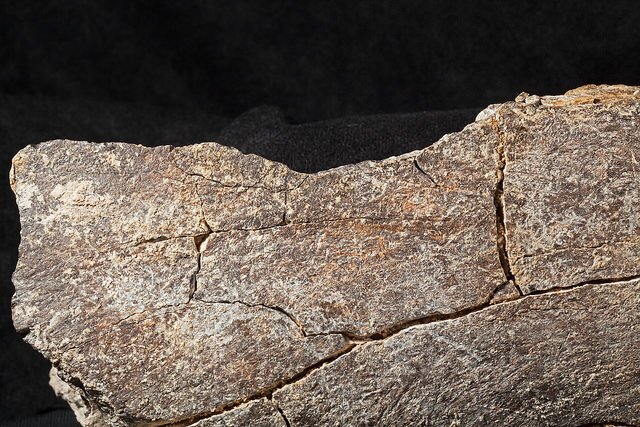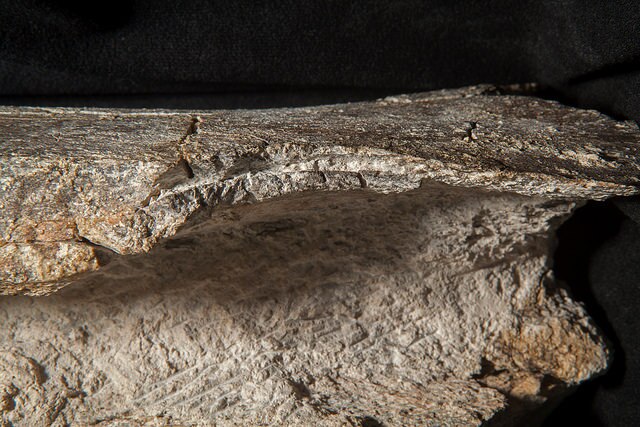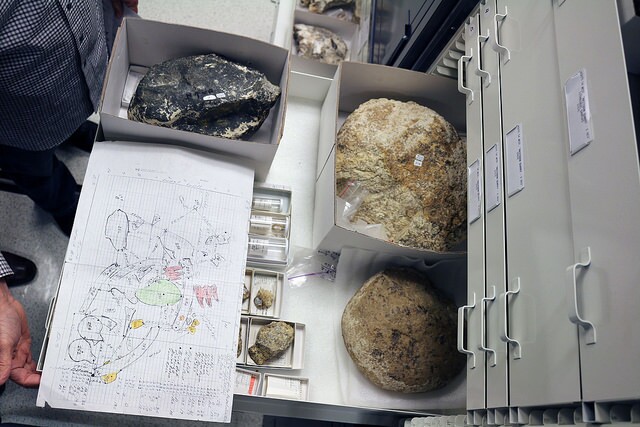
When news of the published study report in the prestigious scientific journal Nature broke, it became a bombshell headline for science media reporters. “Humans in California 130,000 years ago? Get the Facts,” flashed one widely read headline by National Geographic — “A 130,000-year-old archaeological site in southern California, USA,” reported the study abstract from Nature — “Ancient humans may have reached Americas 100,000 years earlier than thought,” posted USA Today. These were but a fraction of the published stories.
To be certain, the authors of the report, including Thomas Deméré, Steven Holen, Kathleen Holen, and other scholars and scientists, knew this would be grist for scholarly skepticism and criticism for years to come. They were braced for it. But the evidence, to them, after years of study, was compelling enough to move forward with their results in a public way. They knew the implication of their study was enormous — humans, or human-like creatures — hominins — were on this continent, at least in the present-day San Diego area, well more than 100,000 years earlier than the earliest generally accepted dates for the first peopling of the Americas, currently established at around 14-15,000 years ago, or based on the recent Bluefish Caves discoveries, possibly at least 24,000 years ago. A very exciting discovery, if one could ignore a legion of scholars shaking their heads in skepticism.
The Discovery
The story began in November 1992, when workers under a California Department of Transportation (Caltrans) highway construction project exposed something curious while excavating with a backhoe on State Route (SR) 54, where San Diego borders National City. As State law requires, paleontologists from the San Diego Natural History Museum’s PaleoServices Department were on site doing routine monitoring of the grading activities, in case any fossil material might be encountered. It wasn’t long before the paleontologists justified their presence, and in a very exciting way. As field paleontologist Richard Cerutti watched the caterpillar backhoe excavate through the sandy soil, he spotted what appeared to him to be a horizontally oriented mammoth tusk bone. Construction work in the vicinity of the finds was immediately halted, and the nature of the excavation changed from one using heavy construction and excavation equipment to one using much finer methods — methods typically used by paleontologists and archaeologists. Excavations continued on and off over a period of five months, and together with the San Diego Natural History Museum’s PaleoServices Director Dr. Tom Deméré and a team of site investigators, the team encountered more fragments, including molars, clearly revealing that what they were looking at were actually the remains of a mastodon, a large mammal that inhabited the region during the Pleistocene, becoming extinct about 10,000 -13,000 years ago.
But there was something else that was tantalizingly peculiar about these remains. As they continued to excavate, they could see that many of the bones were fractured or broken in a way that was not typical of bones broken by the forces of the natural environment. Said Kathleen Holen, Director for the Center for American Paleolithic Research in Hot Springs, South Dakota, and one of the authors of the study: “The fragments were found to be clustered in two distinct areas around rocks. The heavy limb bones, which are useful for making tools, were smashed and broken up, but the lighter bones like ribs and vertebra were more complete. We found characteristic marks on the bone surfaces, notches and scars where flakes of bone had been removed, and this is characteristic of bone that has been broken by percussion, that is, with hammerstones. We also found cone flakes that occur characteristically around the point of impact, much like when you see a B-B strike a window — those circular patterns break off in flakes. In our experience, these bones were broken in patterns usually associated with human modification, broken while they were still fresh.”*
Added to this was the discovery of several large stones found within the same sediment layer as the bones. Finding large stones was not unusual. But finding them located precisely where the modified bone fragments were located was peculiar. “We found stones that were located right within the concentrations [two separate clusters] of the mastodon bone fragments and flakes and the stones and bone fragments could be refit back together so it showed that whatever happened, it was all in the same location,” continued Holen who, along with her husband scholar and study co-author Steven Holen, joined the team efforts in 2008. “We found marks on the rocks that were characteristic of them being used as pounding tools. So there was pounding evidence on both the rocks and on the mastodon bones. Then we saw other signs of human behavior — for example, the location of one of the impacts indicated that there was cooperation between at least two people to steady this bone on an anvil and then break it.”*
The team considered the possibility that this was all a result of natural processes. But the Holens and colleagues could not fit what they saw into scenarios based on natural causes. “We found no evidence that carnivores have interacted with the bones or that there had been a trampling event that broke the bones and there is no evidence of flooding that would have caused the rocks to break the bones because the flooding would have washed away these smaller fragments that were still right with the stones.”
They knew this would not be enough to draw any conclusions, so to confirm or deny their hunch, they turned to additional expertise. One of these experts was Dr. Dan Fisher, a paleontologist from the University of Michigan — an expert on mastodon fossils. Fisher had significant experience excavating mastodon and mammoth sites that exhibited bones broken while they were still fresh. Carefully examining the site and the evidence, he concluded that there were clear signs that the bones had been broken by percussion.
The logical question followed: Were the stones within the clusters really used as tools by humans to break the bones? To answer this question, in 2015 they sent the stones to a well-recognized expert on use-wear analysis, Dr. Richard Fullagar, an archaeologist at the University of Wollongong in New South Wales, Australia. Fullagar examined the stones and compared them to known stone tools, as well as other stones used by the research team to break open fresh elephant bones as an experiment. His conclusion: The stones showed the same abrasions, fractures, and marks that could only come from repetitive impact. To help with further study of the samples, they employed Dr. Adam Rountrey, a colleague of Fisher’s, to produce 3D digital models.
The researchers were unanimous. This looked like an archaeological site — a site, no longer occupied by human or animal, with evidence of past human activity.
But what about that other critical question — the age of the site?
Once they had solid samples to be sent for dating, the team did not waste any time. They were sent to USC geologist Dr. Richard Ku for analysis using the radiometric (U-Th) dating techniques of the time (1992/1993). On December 29, 1993, Ku called Deméré with some startling news — a caliche (sedimentary rock) sample from the Cerutti mastodon sediment layer yielded a date of about 190,000 ka. Deméré nearly fell out of his chair. In January, 1994, Ku sent the formal letter report of the dating results. But the Cerutti mastodon site, as far as the mainstream scholars were concerned, joined the plethora of American paleo-indian sites considered as questionable in terms of age. It wasn’t until almost two decades later when they again sent samples for dating, this time to Dr. James Paces, geologist and geochronologist at the U.S. Geological Survey. From 2012 to 2015, Paces applied more advanced and reliable Uranium radiometric dating analyses on “prepared multiple specimens, performing digestions, chemical separations and purifications, and complete isotope analyses on nearly 100 individual subsamples”.** The result: The mastodon bones and associated stones were buried in sediments that are about 130,000 years old, give or take 9,400 years.
With this, the research team was ready to go public again, and in 2016 they submitted their report to Nature for review. The report was published in 2017, and the news broke in major venues across the world — humans may have been in the Americas more than a whopping 100,000 years before the earliest known dates for the first peopling of the continents.
Deméré, the Holens, and the rest of the research group anticipated that this would ignite controversy. And sure enough, it generated a firestorm of criticism across a broad spectrum of the scholarly community, especially among scientists involved in First Americans research.
______________________________________
San Diego Natural History Museum paleontologist Richard Cerutti (after whom the site was named) observing an excavator expanding the Cerutti Mastodon site, March 1993. Courtesy San Diego Natural History Museum.
_________________________________________________
View looking east of the Cerutti Mastodon site, November 1992. Courtesy San Diego Natural History Museum.
___________________________________
Caltrans archaeologists Karen Crafts, Chris White, and Don Laylander excavating fossils found at the Cerutti Mastodon site, November 18, 1992. Courtesy San Diego Natural History Museum.
__________________________________________________
Brett Agenbroad (top left), Larry Agenbroad (left), James Mead (bottom left), and Dr. Tom Deméré excavating fossils found at the Cerutti Mastodon site, December 29, 1992. Courtesy San Diego Natural History Museum.
_________________________________________________
Vertebrate paleontologist Dr. James Meade and Director of PaleoServices Dr. Tom Deméré observing an exposed rib and femur ball in the upper right corner of excavation unit D-3 at the Cerutti Mastodon site. Courtesy San Diego Natural History Museum.
___________________________________________________
Mastodon skeleton schematic showing which bones and teeth of the animal were found at the site. Courtesy San Diego Natural History Museum.
___________________________________________________
The Archaeological Site That Can’t Be
Clearly, the Cerutti Mastodon (CM) site findings up-ended the emerging concept on the timing of the first peopling of the Americas in a major way, and the big names in research on the subject were not going to let this go unchallenged. But the dating itself was actually not the biggest problem for the critics. The process and techniques used on the CM site dating are broadly considered to be the most reliable and accurate that could have been done to date. “Basically we have to believe the date,” says Warren Sharp, an expert on radiometric dating. “The date is not the question in this study. There have been lots of people that have claimed that they had some kind of archaeological evidence for people earlier than 15,000 years ago or so. But if this really passes muster, then I think all of those sites and all of those claims are going to be looked at with new eyes and people are going to not just dismiss them out of hand.”*
So with the age set aside as a point of contention, the real problem lies in the interpretation of the site as an archaeological site — a location that bears evidence of human occupation or activity. The most salient critiques have revolved around a widely held principle: that extraordinary conclusions or findings require an extraordinary preponderance of credible evidence. They have to meet several crucial tests, namely, that “(1) Archaeological evidence is found in a defined and undisturbed geologic context; (2) Age is determined by reliable radiometric dating; (3) Multiple lines of evidence from interdisciplinary studies provide consistent results; and (4) Unquestionable artifacts are found in primary context”.***
One of the biggest points of contention centers on the suggestion that the ‘hammerstones’ and ‘anvils’ are indeed artifacts, the fourth test as noted above. “To demonstrate such early occupation of the Americas requires the presence of unequivocal stone artifacts,” says Michael R. Waters. Waters is a prominent scholar on the archaeology of early Americans and has held the Endowed Chair in First American Studies at Texas A&M University, the directorship of the Center for the Study of the First Americans, and serves as the Executive Director of the North Star Archaeological Research Program. Waters has been at the forefront of research with his discoveries of evidence of early American occupation as much as 14,000 – 15,000 years ago at such locations as the Debra L. Friedkin site in Texas and the Page-Ladson site in Florida. Regarding the Cerutti Mastodon site, however, he asserts “there are no unequivocal stone tools associated with the bones.” The stones described at the Cerutti mastodon site simply don’t meet the stringent standards required to be designated as artifacts, he maintains.
Tom Dillehay, the renowned anthropologist with Vanderbilt University who was key to the claimed discovery of a 14,500-year-old human presence at Monte Verde, Chile, agrees. He says that the Cerutti site study does not fully rule out the possibility that the stones were moved to the site by natural processes, and that the wear patterns on the stones may have been the result of the stones bumping against other stones in a moving stream.
“Holen has made similar claims for other sites he has worked on in the Midwest,” says James M. Adovasio, the archaeologist who led the famed excavations of the Meadowcroft rock shelter in Pennsylvania, where evidence of human activity dated to at least 16,000 years ago was discovered. “These sites have also been roundly critiqued because he has not effectively ruled out other means by which the bones may have accumulated. This is perhaps the biggest problem with all such sites. Specifically, is there a natural, non-anthropogenic, possible explanation for the bone accumulations and their patterning? In the case of Cerutti and the Midwestern localities, this question has not been answered.”
Another argument against the Cerutti site raises the problem of a clear absence (thus far) of bifacial stone tools, a technology that was well-established by 130,000 years ago and would likely have been transported to the New World by its original prehistoric Old World settlers coming from the west. “Though bifacial technology is well developed at this time in the Old World, there is not a shred of it at Cerutti,” says Adovasio. “It is obviously not absolutely necessary that bifacial technology be present on such a site,” he adds, but “all of the bona fide Old World sites of this time period exhibit such materials”.
And then there are the bones. Skeptics are not convinced that the large bones, including teeth, were broken by humans using the ‘hammerstones’ and ‘anvils’, as the study suggested. “If, as the authors claim, they are splitting bone for marrow and/or tool production,” says Adovasio, “why are all of the pieces from these processes still there? They all retrofit. Additionally, no one splits teeth for marrow!”
Another voice of caution has been expressed by Briana Pobiner, a paleoanthropologist at the Smithsonian Institution and a noted expert on recognizing human activity through the examination of bones.
“What concerns me most about the CM site is a lack of any butchery marks on the mastodon fossils – and the lack of stone tools,” she says. “Interestingly, at ethnographic and some archaeological proboscidean (elephants and their extinct relatives) butchery sites you sometimes don’t see any butchery marks because these animals are so big that you can easily cut meat off of them without leaving any butchery marks — but that’s when the goal is meat processing. To break open the bones for marrow, you need to strip all the meat away, including the connective tissue (like periosteum and cartilage) surrounding the bone, which can be up to 3mm thick on elephants. It seems odd not to see any evidence for that kind of processing [at this site] — nor for the tools used to do that processing.” However, she added, “perhaps the bone could still be “fresh” after the connective tissue has decayed away. In a 2015 paper, Haynes and Klimowicz noted that elephant limb bones can retain grease for up to 3 years, and retention of grease likely means spiral fracture” when attempting to break open bones for access to marrow. This contrasts with bones when they are dry and past the fresh stage, when breakage is characteristically “jagged, longitudinal, or parallel to the long axis of the bone”.
But Pobiner is not totally convinced that the Cerutti bone spiral fractures were necessarily caused by humans.
“Researchers used to always attribute spiral fracture to human activity, but a few decades ago it was demonstrated that carnivore chewing and other activity can spirally fracture bone –- it’s indicative of the timing of breakage, not the cause of breakage,” she added. “Gary Haynes, an expert on proboscidean butchery, has studied hundreds of natural elephant bone sites in southern Africa, and found that at some sites up to 62% of the limb bones are spirally fractured” by natural causes.
The Defense
The study authors, on the other hand, are confident they have a strong case for further testing and investigation.
“Only a few of them produce the full banquet of evidence that would be convincing to a really wide range of people,” says Fisher, a key participant and co-author of the study report, about sites like the Cerutti case. “I think the Cerutti site produces that full banquet in a way that very few others do. At the same time the nature of the evidence that is there is completely parallel, completely consistent with patterns that we see at other sites. So not only do I not have a problem with interpreting this as human activity, but I feel I would be intellectually dishonest to turn away from this and say, well, it can’t be human activity only because it’s too old. It’s the same as we see in the best cases where we argue for human activity.”
And while some of the best scientists around the world are itching to poke holes in those statements, the Cerutti site team points to a list of reasons why they think their case is convincing. As published for the media by the San Diego Natural History Museum, the researchers had the following to say:
Regarding the argument that the finds may have been caused by other natural or geological events:
— The pattern of the mastodon bone bed differs from that of the skeletons of horse, dire wolf, and deer discovered in other strata within the same Pleistocene rock;
— the occurrence of large and small bones together with five large cobbles within an otherwise sandy silt horizon indicates that fluvial processes did not transport the bones and rocks; and
— we studied sites where flood events left bone material redistributed. At those sites, moving water sorted the bones by density and size. This wasn’t the case at the Cerutti Mastodon Site, where everything from small molar fragments to large rocks were distributed, unsorted, around the site.
Regarding any argument that the bone breakage observed at the Cerutti site may have been caused by animal gnawing or other behaviors:
— No Pleistocene carnivore was capable of breaking a fresh mastodon femur at mid-shaft or producing the observed wide impact notch;
— The presence of attached and detached cone flakes is indicative of hammerstone percussion, not carnivoran gnawing, and there is no carnivore bone modification at the Cerutti Mastodon Site nor bone surface modification from gnawing;
— The differential preservation of fragile ribs and vertebrae rather than heavy limb bones argues against trampling (also no telltale trampling markings) and is consistent with selective breakage by humans; and
— Other skeletons of extinct mammals found in the same layer/strata were found relatively intact.
Regarding the conclusion that there is evidence of human activity at the site:
— The distribution pattern of bones – they were not distributed across the site in a homogenous fashion, but were instead concentrated in two key areas;
— [Again,] the pattern of differential breakage – more fragile bones were intact while the heaviest/strongest were broken;
— The pattern of breakage itself — spiral fractures indicated breakage of the bones when fresh. Impact notches and cone flakes indicated breakage from percussion;
— The way in which the rocks were broken — pieces of broken rock were found scattered throughout the site, in many cases far away from the rock they came from; and several pieces could be refitted, indicating how and exactly where particular stones broke;
— There were two main areas of concentrated bones and rocks;
— [What appeared to be] purposeful placement of some objects — mastodon femoral heads placed together side by side and the tusk driven vertically into lower sedimentary layers were two examples of these anomalies; and
— [Again,] the discrepancy between how the fossils were preserved compared to other Ice Age megafauna discovered at the same site – a sloth, a camel, an ancient horse, a dire wolf, and a capybara — which were the same age. These other animals were mostly the entire carcass/fully articulated skeletons; the mastodon was much more incomplete, and remaining bones were disarticulated and broken.***
Finally, Fullagar, upon examining the purported stone tools from the site, is convinced that the subject stones were actually used as tools. Without knowing the age of the site and their apparent association with the mastodon bones, Fullagar examined key sample stones as submitted by the site archaeologists for study. “Initially when we looked at them I was thinking perhaps they were some kind of plant processing or animal processing tool, for grinding up plant materials or small animals,” said Fullagar. “We’re able to look at these [stones] in low and high magnification and also check whether or not we can see marks that are distinctive of a stone on a bone or a stone on stone.” He found markings indicating stone on bone. “It turned out after I knew a bit more about the site [after examining the bones] that they were used for smashing up mastodon bones,” said Fullagar.
_______________________________________
A concentration of fossil bone and rock. The unusual positions of the femur heads, one up and one down, broken in the same manner next to each other is unusual. Mastodon molars are located in the lower right hand corner next to a large rock comprised of andesite which is in contact with a broken vertebra. Upper left is a rib angled upwards resting on a granitic pegmatite rock fragment. Courtesy San Diego Natural History Museum
____________________________________________________
Unbroken mastodon ribs and vertebrae, including one vertebra with a large well preserved neural spine. Courtesy San Diego Natural History Museum
__________________________________________________
A view of a unit containing several fossil remains and stones. Courtesy San Diego Natural History Museum
_____________________________________________
A close-up view of a spirally fractured mastodon femur bone. Courtesy Tom Deméré, San Diego Natural History Museum
____________________________________
The surface of mastodon bone showing half impact notch on a segment of femur. Courtesy Tom Deméré, San Diego Natural History Museum
________________________________________________
Side view of groove produced by percussion on a mastodon leg bone. Shows negative flake scar. Courtesy Tom Deméré, San Diego Natural History Museum
________________________________________________
A boulder discovered at the Cerutti Mastodon site thought to have been used by early humans as a hammerstone. Courtesy Tom Deméré, San Diego Natural History Museum
__________________________________________________
One of the stones discovered at the Cerutti Mastodon site thought to be used as an anvil for bones processing. Courtesy Tom Deméré, San Diego Natural History Museum
___________________________________________________
 Layout depicting bone breakage experiment on a modern elephant’s leg bones in an attempt to determine the kinds of breakage patterns resulting from hammerstone percussion. Courtesy Kate Johnson, San Diego Natural History Museum
Layout depicting bone breakage experiment on a modern elephant’s leg bones in an attempt to determine the kinds of breakage patterns resulting from hammerstone percussion. Courtesy Kate Johnson, San Diego Natural History Museum
___________________________________________
What kind of human?
There were no human remains found at the site associated with the finds. But even if it could be irrefutably concluded that humans were at the site 130,000 years ago, what kind of human would we be talking about in this case? At that time in prehistory scientists know that, along with modern humans, other hominins like Homo erectus, Neanderthals, Denisovans, and possibly Homo floresiensis (the Indonesian “hobbits’) were walking the earth, and perhaps at least one other as yet unidentified early human species. However, all of these human populations are known to have existed only in the Old World. There is at this time no evidence that any species of human had journeyed beyond the Old World continents any earlier than between 20,000 – 30,000 years ago, a time when there are clues that humans may have been hanging around the ancient Beringian region (which includes present day Alaska and ancient easterly extensions of present day Siberia). And while it is possible they may have been modern humans (not archaic humans), there is no broadly accepted evidence to date that modern humans had left Africa to colonize the world by 130,000 years ago. Most estimates place them exiting Africa much later.
This leaves hominins like Homo erectus, the first generally recognized globe-trotting human species, Neanderthals (known to have existed in Western Eurasia and the Middle East and as far east as the Altai Mountains in Siberia), Denisovans (known to have existed as far east as Siberia and possibly Melanesia and Australia), Homo floresiensis (Indonesia), or some other unknown species. Any of those possibilities would be game-changing. Especially given the geographic realities of the time….
If a human presence is confirmed, then how did they get here?
The age range of the site falls within the Eemian interglacial period, a time when sea level was high enough to create a water barrier for theorists who posit that early humans crossed Beringia, the land bridge area that many scholars suggest facilitated the entry of humans into the Americas during prehistoric times. This would suggest that early human arrivals in the Americas would have had to reach the Americas by some kind of watercraft — or that their ancestors crossed into the Americas considerably earlier than 130,000 years ago, when sea level was lower and Beringia was above water. Either scenario would be considered by mainstream conservative thinkers to be a real stretch.
But there are some findings in other parts of the world that suggest that humans were capable of crossing significant bodies of water in deep prehistory with boats of some sort. The evidence is indirect, but they present a compelling possibility. One example, on the Cycladic island of Naxos, Greece, could hold a clue.
First discovered in 1981 as part of a survey by the École Française d’Athènes under the direction of René Treuil, the site, known as Stélida, is a 118m high hill on the west of cape of Aghios Prokopios, located on the northwest coast of Naxos. Today the hill is situated on a promontory that juts out into the Aegean, and if one stands at its pinnacle, one can view a vista of the coastline and the Aegean Sea toward the west, separating Naxos from its neighboring island, Paros, clearly seen in the distance. Beginning in 2013, an international team led by Dr. Tristan Carter of McMaster University through the Canadian Institute in Greece, and his co-director Dr. Demetris Athanasoulis of the Cycladic Ephorate of Antiquities of the Hellenic Republic’s Ministry of Culture and Sports, conducted a series of ongoing excavations on the hill. Known as the Stélida Naxos Archaeological Project (SNAP), excavations have uncovered thousands of lithic material (mostly stone debitage), that indicate the site was in use for tens of thousands of years as a place to acquire and manufacture simple stone tools. According to the project scientists, many of the diagnostic pieces, although not an indicator for direct or absolute dating, do suggest a possible date range of hominin occupation or use going back as far as the Middle Paleolithic (spanning from 300,000 to 30,000 years ago). Says Kate Leonard, an archaeologist who worked at the site, “There is tantalizing evidence for activity at Stélida in the form of possible bifaces that could be interpreted as handaxes; these large heavy tools could have been made by Homo heidelbergensis, the predecessor of the Neanderthals in Europe. The possibility for evidence of these early hominids living on what are now the Cycladic islands has not been seriously investigated before.”
____________________________________
Stone tools in situ at Stélida. Photo credit Kate Leonard
________________________________________________
Perhaps the most intriguing aspect of Stélida, however, is its location on an island that, during the Middle Paleolithic, would have presented some challenge for access by humans. “Stélida is the earliest known archaeological site in the Cycladic region and when the area was first reached by hominins the landscape would have been much different to now,” says Leonard. “When I looked out from my excavation trench towards the coast I could see the Aegean Sea separating Naxos from its neighbor to the west, the island of Paros. Scientific investigations into the ancient environment suggest that these two islands were joined to a few others as part of one big island known as the ‘Cycladean Island’ during the glacial maximum (the stage of the Ice Age when the maximum amount of sea water was trapped in glaciers). Tens of thousands of years ago when people climbed the hill at Stélida to reach the chert outcrops they would have been looking out over a grassy plain, an estuary or even a lagoon, with the sea many kilometers away. But even still, this ‘mega-island’ was an island and a body of water had to be crossed to reach it from mainland Europe.” Early humans were already known to have existed in mainland Europe at this time, such as Neanderthals, Homo heidelbergensis, and possibly Denisovans.
The clues don’t stop with Stélida. Another site called Mochlos on the island of Crete has revealed stone tools that may be as much as 130,000 years old. The Mochlos site had to have been reached by humans by crossing water, as it was never connected to the Greek mainland. And yet other sites in the south of Spain show evidence of human activity or presence as much as 900,000 to over a million years ago at locations that suggest early humans had to have crossed the Straits of Gibraltar from northern Africa to reach the sites.
Looking ahead — the need for more sites?
So does the Cerutti Mastodon Site show plausible evidence that humans were at the site 130,000 years ago?
Broad scholarly consensus on that question is for now only a fiction. Human bones would certainly cement the case, but there are no telltale early human bones, and that is not unusual. Many prehistoric sites showing clear evidence of human activity do not feature human bones. But DNA research has opened up an intriguing possibility for investigating such sites. Using newly developed techniques, researchers of the Max Planck Institute for Evolutionary Anthropology in Leipzig, Germany, have recently successfully retrieved and identified DNA from Neanderthals from sediment samples taken from four archaeological cave sites, as well as DNA of Denisovans from soil samples from the Denisova Cave in Russia. The DNA was identified in sediments where no hominin skeletal remains have been detected. Scientists now suggest that the same process can be applied at other sites across the world. Why not the Cerutti site?
Aside from breakthroughs like new DNA techniques, Deméré and colleagues hold out for more research and study before cementing their case. They suggest that, now that the Cerutti site has opened up a new possible time range for human occupation in the Americas, it may serve to inspire or direct other researchers or archaeologists to search in areas and sediments/time horizons that were previously ignored or not thoroughly explored. More data and possible evidence from other locations is needed before the Cerutti site can be corroborated within the scholarly world. They are moving forward with this. For starters, says Steven Holen, “we have some preliminary evidence from another site,” that will be explored further.
He wouldn’t reveal the location of the site. Not yet.
__________________________________________
A drawer full of Cerutti Mastodon site stone artifacts in the San Diego Natural History Museum’s Paleontology Collection Room. Courtesy Kate Johnson, San Diego Natural History Museum
_________________________________________
*Interview on Science Friday, April 2017
** CMS Discovery Timeline, San Diego Natural History Museum
***CMS Fact Sheet, San Diego Natural History Museum
_______________________________________________________


